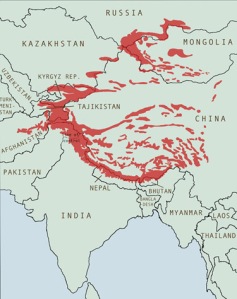The Xinjiang Snow Leopard Project team is back in China – and they’ve expanded their work from just Xinjiang province to across China, a very big task and we wish them luck!
The project has been running for a few years and is headed up by Philip Riordan, senior researcher at Oxford University’s Wildlife Conservation Research Unit. Philip says in his blog “ we’re being encouraged by the Chinese authorities to include other provinces in our project. Kun and I paid a visit to Sichuan in the summer and were delighted to find signs of snow leopard in Wolong Biosphere Reserve and giant panda hang-out. We have support from the local forestry administration and hope to survey areas on the eastern edge of the Qinghai-Tibetan Plateau in the coming winter, so expect more boring discussion of warm clothing and ice! Excitingly, the Sichuan Forestry Administration have taken some photos of snow leopards using remote camera traps and I hope to be able to post these up soon.”

Snow leopard photographed by the Xinjiang China Snow Leopard Project in Wolong Nature Reserve, China.
What I especially like about Philip’s approach is his empathy with the local community as well as the endangered cats he’s researching and trying to save. Commenting on a recent prosecution in Xinjiang of two farmers accused of killing a snow leopard Philip says, “These are farmers from a very poor community, trying to protect their family interests and stop a snow leopard taking their livestock. Hard line conservationists will view any illegal killing of endangered wildlife as a serious and punishable crime. Legislation in China, and other countries, to protect endangered species enshrine this principle, but less than hard-liners hope that court systems will allow for some sensitivity.
“We need sensitivity, because the people living and working with snow leopards and other dangerous or damaging wildlife hold the solution to their protection. In an ever increasingly crowded world, we cannot separate people from these animals, so we must find ways to ensure that vulnerable communities are not disadvantaged by the goals of conservation.”
This is an exciting project and you can catch more about how its going on Philip’s blog here.





 Posted by Sibylle and Rex
Posted by Sibylle and Rex 









